
Some say size matters, while others point out that bigger is better. Kia’s product planners must have overheard the ladies from the next table discussing the ideal size of a man’s tool before coming up with the third-generation Kia Sorento, dubbed Man on the Road in South Korea. The tool we meant is the Sport Utility Vehicle, of course.
The new Kia Sorento is one big beast of an SUV. It was always ‘half a size’ larger than the regular family soft-roader (think Honda CR-V, Nissan X-Trail), the Sorento, but this third-gen SUV’s size breaks the segment’s glass ceiling. You’ll have to see it in the metal to comprehend the scale we’re talking about here.
So is the biggest also the best? We drove the Sorento around the hills overlooking the Dead Sea to find out.
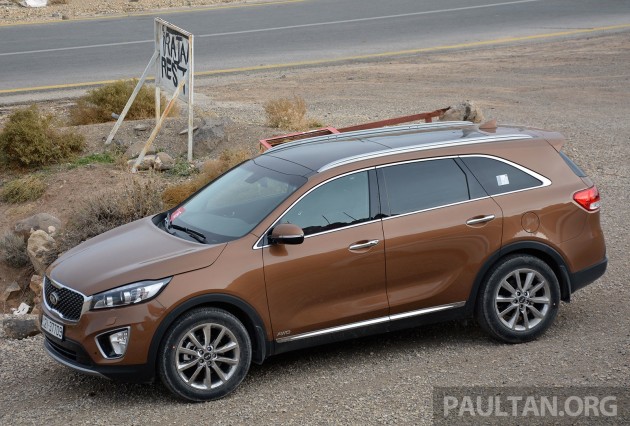
You won’t get to see the new Kia Sorento in Malaysia till the fourth quarter this year (earlier news of a June/July arrival was inaccurate), so here’s some perspective for you to pigeonhole it. The Honda CR-V, which everyone is familiar with, is one of the larger C-segment SUVs and our benchmark here. It measures 4,590 mm long and 1,820 mm wide, with a 2,620 mm wheelbase.
The current Hyundai Santa Fe, which to us occupies the ‘half a size larger’ slot along with the second-gen Sorento, is 100 mm longer and 60 mm wider than the Honda, with a 2.7-metre wheelbase. Now, the Santa Fe is a muscular SUV with three-row seating, but it is simply dwarfed by the new Sorento, which has dimensions that will please the Americans.
At 4,780 mm long and 1,890 mm wide, the big Kia is 90 mm longer than the Santa Fe, and 80 mm of that advantage goes into the 2,780 mm wheelbase; the same (95 mm longer, 80 mm extra wheelbase) applies when it’s side by side with the outgoing Sorento. Much of the newfound length can be seen in the larger rearmost windows. Versus the CR-V? 190 mm longer, 70 mm wider, 160 mm wheelbase advantage.
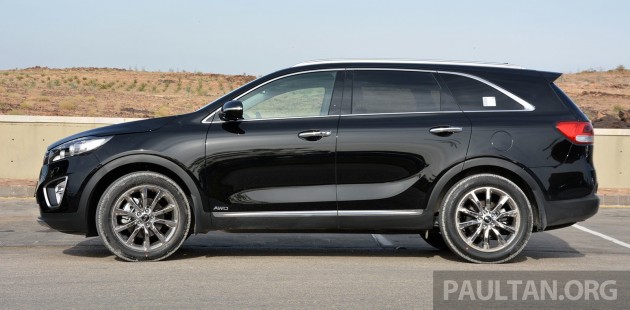
You’d probably have gathered from the pics that the Sorento’s body is long and wide, but not particularly tall, and you’re right. At 1,690 mm, it sits 15 mm lower than the old car and stands equal with the Santa Fe; both are just 5 mm taller than the CR-V. Like a wagon that has spent too much time in the gym is how we see the proportions. The glasshouse is pretty narrow for a car this big, too.
The big guy – a nice evolution of the Cross GT concept from 2013 – wears a handsome suit that avoids looking too showy, but with bling in the right places. A wide, upright front grille dominates the face – it’s decorated with a sea of Mercedes A-Class-style ‘3D diamond’ studs, framed by Kia’s trademark ‘tiger nose’. Following today’s trend, the grille is ‘connected’ to the twin-barrel headlamps with ‘eyebrow’ DRLs.
The rear end is pretty conventional, with rectangular wrap-around lamp clusters flanking the license plate. The tail lamps light up in a cool fork pattern, with three ‘U’ shaped elements lighting up inside during braking – it’s a lot more classy than the current car’s super thick LED bars, but no less distinctive.
The modest 185 mm ground clearance and approach/departure angles of the Sorento don’t look very conducive for off-roading, but skid plates are part of the front and rear ends, affixed to black plastic cladding that surrounds the underbody for the all-important macho 4X4 look.
Kia has four wheel designs ranging from 17 to 19 inches. The ones you see here are the largest, and they look right at home under the Sorento’s hulk of a body. ‘Chrome Sputtering’ rims sound icky, but the shiny multi-spoke items look right here, somehow. Must be the ‘American’ flavour of the Kia.
Speaking of that, the new Kia Carnival MPV shares the Sorento stance, bling grille and chrome wheels – both look like they’ve been designed together, and will fit right into the American suburbia we see on TV.
The Sorento’s shape is squarish but there are no sharp edges and lines in sight. Nothing groundbreaking in terms of design, and some would even accuse Kia of being unadventurous, but the Man on the Road is a handsome big SUV projecting a confident and substantial image. I like it. If the Sorento could talk, it would be asking the new Audi Q7: “Missing an ex-designer over in Ingolstadt?”
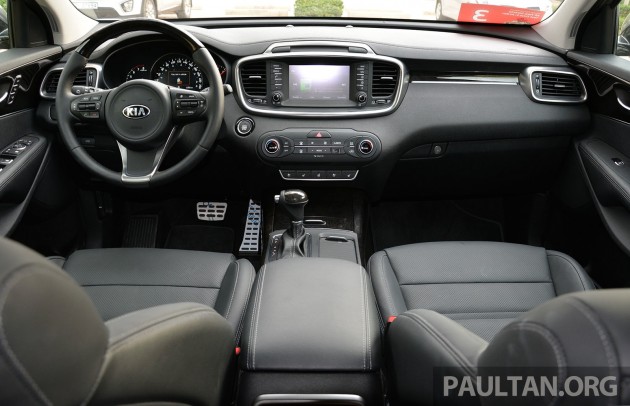
The clean and classy theme is carried into the cabin, which design was led by Kia Europe. Like the exterior, it avoids looking too complicated, something sister brand Hyundai prone to. The size of the car and its width, especially, is emphasised by the dashboard’s horizontal layout and vast vacant space.
Naza Kia should be specifying an all-black cabin for our market, as per the image above. Pretty sombre, but Malaysians like their car interiors safe, we are told.
Silver ‘satin-chrome’ air con vents protrude from the dash to provide much-needed accents; the middle vents flanking a touch screen head unit that includes physical buttons on the sides for ease of use. The HU you see here is a navigation-included option that will probably be replaced with Kia’s regular 4.3-inch factory touch screen unit for Malaysia.
The push start button, AC panel and another row of buttons below it are the only other elements on the dash. The latter, which houses buttons for the seat heating/cooling and heated steering wheel, would stick out quite a bit if those functions aren’t specified, we reckon.
Drive related functions are clustered together with the electronic parking brake (which replaces a foot-operated brake) behind the gear lever. Blind Spot Detection makes an appearance, lighting up an alert on the outer tip of the wing mirrors when a car approaches the Sorento’s blind spots.
Another upgrade is the instrument panel, which is now a seven-inch TFT-LCD Supervision cluster. The colour screen inside the central speedo shows the usual trip computer info, park assist and Flex Steer steering modes. The three-spoke steering wheel is similar to the one in the Optima K5 facelift, but without the sedan’s flattened bottom, while the wiper and light stalks have been changed from the cheap old Hyundai-Kia shiny items to nicer ones, as seen in the Santa Fe.
Some would find the dashboard a little bare for a big SUV, as there’s no iDrive-style central controller or lots of buttons, but I’m a fan of the minimalist look. None, however, would argue that the quality of materials have improved over the previous-gen (higher proportion of soft plastics, stitched dash top, trim that’s more premium in look and touch) and all the elements are put together tightly.
This two-pronged upgrade in design and perceived quality gives the new Sorento a premium feel non-existant in the outgoing car, which now feels utilitarian in comparison.
One can’t veer too far away from its size when discussing the Sorento, and here we go again. The two front chairs are generously sized and comfortable over long distances. Highly adaptable to driving positions too, with 10-way power adjustment plus four-way lumbar support for the driver, and eight-way movement for the front passenger.
Our test car also came with heated and ventilated seats, plus the optional powered thigh extension for the driver’s seat – I didn’t need the latter but longer legged drivers would appreciate the extra support. Front headrests move up and down, fore and aft, via a (manual) single button, allowing for single handed adjustment.
If the dashboard design offers an impression of great width, the couple distance and wide centre front armrest is physical evidence. Generous elbow room aside, it opens to a deep bin that made my DSLR look like a compact camera.
As expected, no space issues for those at the back. Second row occupants get their own air vents, a USB port and a 12V outlet to charge devices. The seat backs are adjustable, and the bench has a sliding range of 270 mm for improved access to the third row, but entry could be easier still if the seats tumble forward.
Seats six and seven are of a decent size, and there’s good width back there, relatively. Knees will be pointing up, as expected, but there’s enough room for smaller sized adults, with the bonus of air vents (with dedicated fan speed control), cupholders and bins.
While not quite a full-sized seven-seater, the Sorento’s extra row is more liveable than in many 5+2s. A sliding second row means that a compromise can be struck, and there’s a small gap for third-row feet to tuck into. All get to enjoy natural light from the full-length, dual-pane panoramic glass roof on cloudy days.
When not in use, the third row can be folded down 50:50 via levers on the boot walls. There’s an underfloor compartment for the detachable tonneau cover, which covers the 605 litre cargo space in five-seater mode. The second-row split folds 40:20:40 for various seating and cargo configurations.
On the options list is Smart Power Tailgate, which opens the hatch automatically when the key fob is in close proximity with the car’s back for over three seconds. Press a button on the tailgate to close.
A total of five engines are available with the new Sorento globally, including a 2.4 litre GDI unit, 2.4 litre MPI, 3.3 litre MPI V6 and two diesels from the R-series. The previous-gen Sorento was hamstrung in Malaysia with just the one petrol engine to choose from, so it’s good news that the diesel will also be available this round. The new range will mirror the Santa Fe’s – 2.4 petrol, 2.2 diesel.
The 2.4 petrol isn’t the perfect match for the big Kia. The naturally-aspirated four-pot’s 176 PS and 227 Nm is good enough for D-segment sedans, but an SUV this big works better with more torque at its disposal. It’s not the motor’s lack of grunt per se, but a by-effect that sticks out – the six-speed auto is made to hunt for the right gear, often resorting to noisy downshifts and less than smooth progress. Serviceable, but not ideal.
The 3.3 litre V6 is much better suited to the Sorento. The Lambda II MPI unit with 270 PS and 318 Nm doesn’t blast off the line; it still needs to be worked for fast progress, but the slushbox is more at ease and the engine sounds a lot sweeter. If fuel and road tax weren’t factors, this would be our pick.
But a Kia Sorento isn’t a money-no-object kind of buy, which is why the diesel engine is the smart choice. The 2.2 litre CRDi packs a strong 200 PS and 441 Nm from 1,750 to 2,750 rpm, and is the best balance between grunt and efficiency in the range. The oil burner wasn’t available at the drive event, but we know it from two generations of the Hyundai Santa Fe. There will be a refinement trade-off choosing it over the 2.4 petrol, but the improved drivability and response outweighs it.
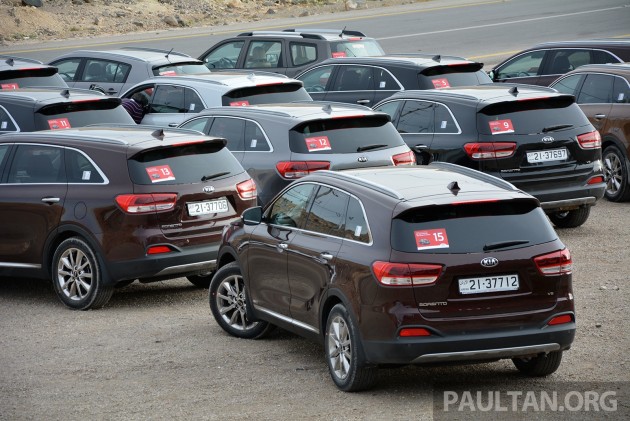
Speaking of refinement, that’s one aspect that has been noticeably improved over the old car. You’ll hear less of the road and drivetrain, save for those 2.4L kickdown moments, we must add. Kia confirms that NVH reduction was a main goal, and that the increased torsional rigidity of the new bodyshell (up by 14%) provides a good base for both enhanced refinement and improved safety.
The Sorento recently achieved one of the highest Australasian New Car Assessment Program (ANCAP) scores ever – 36.62 out of 37 in the more stringent 2015 criteria – en route to collecting five stars, by the way.
Specific noise, vibration and harshness reducing measures adopted include new soundproofing material for the transmission tunnel, a 29% thicker dashboard soundproofing panel, bigger engine and transmission mounts and, for diesel models, a new diesel particulate filter cover and an acoustic shield integrated into the engine’s timing chain cover.
The improved refinement works in tandem with the Sorento’s good ride comfort. The big Kia did highway runs with the sort of authority its size suggests, and cushioned the bumps and ruts of our mild off-road course (new Dynamax AWD with 50:50 lock not needed) well on 19-inch rims. The Jordanian B-roads that we drove on were of decent condition, certainly better than in the Klang Valley, so a local drive might be needed before we give the ride an unqualified thumbs up.
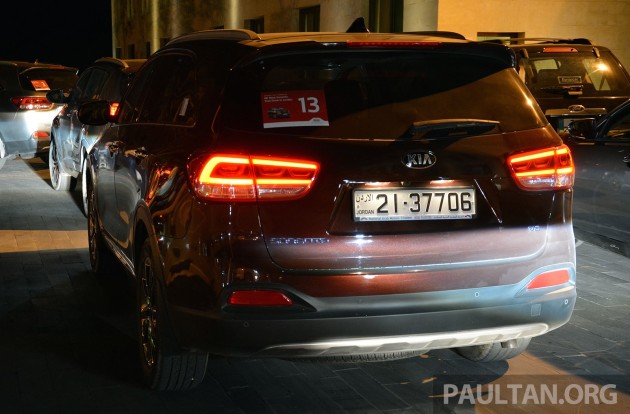
We drove till dark, climbing the hills from our Dead Sea base and touring the valleys before descending to the coast. It was a long drive, and a large portion of it was done in a convoy that didn’t exceed 90 km/h. I remember being restless behind the wheel, but as the day progressed, this writer came to appreciate the Sorento’s mile-munching ability. It’s a soothing car to drive long distances with, and a great family roadtrip partner, I can imagine.
A large, non-sporting SUV isn’t the right tool to attack a B-road with, but the Sorento won’t tip over the moment it sees a corner. Decent grip and control for something this large, really, but it’s not a car you take out to scratch the driving itch. Not as fun to drive as a BMW X3, but sheer driving pleasure is not within its remit.
The power to surprise is what the new Kia Sorento is supposed to do, and it has succeeded, for me at least. After the quantum leap of the previous generation, the younger Korean brand has struggled to consistently induce jaw-dropping improvements. But the Sorento, if priced near the top-spec CR-V(RM169,800) and X-Trail (RM165,800), would be a great buy. In this case, it’s both bigger and better.
- Source: paultan.org

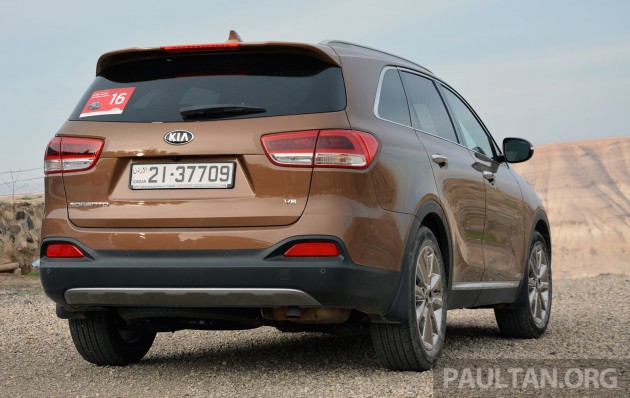
No comments:
Post a Comment